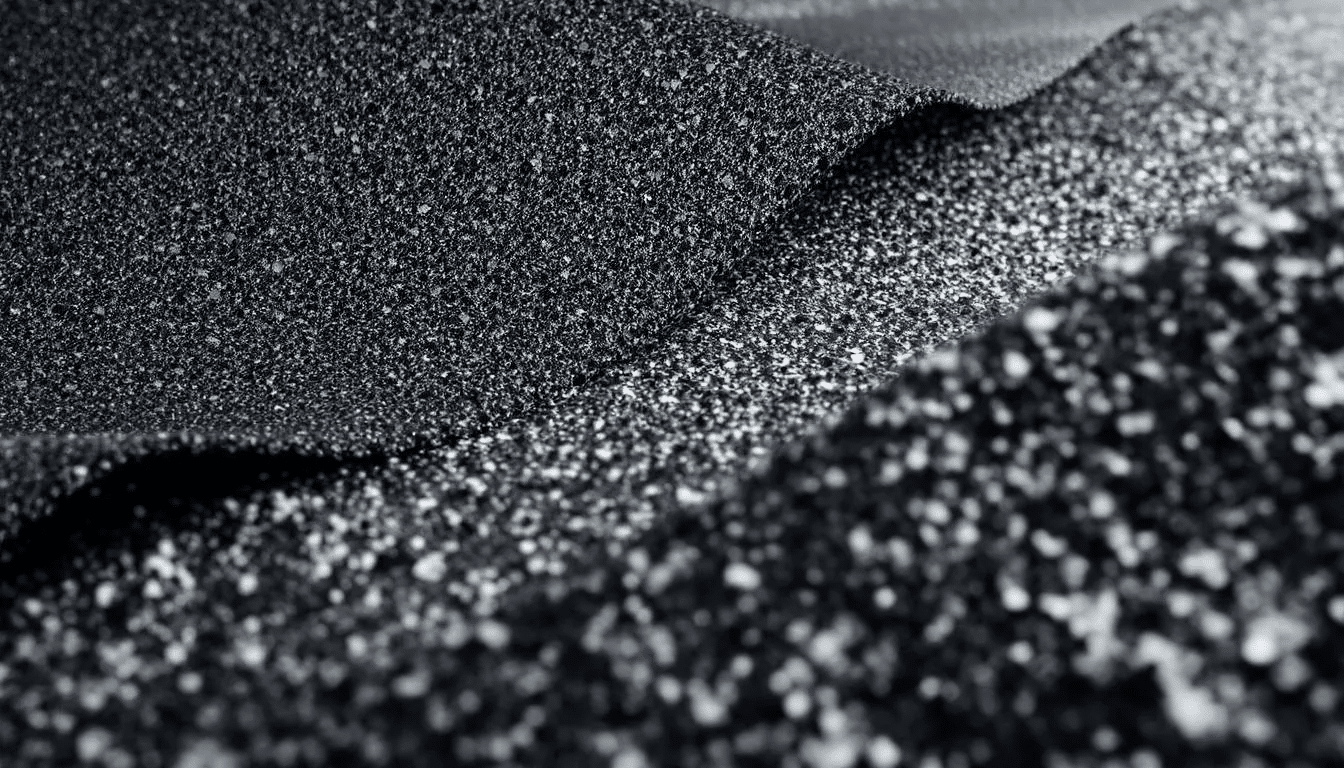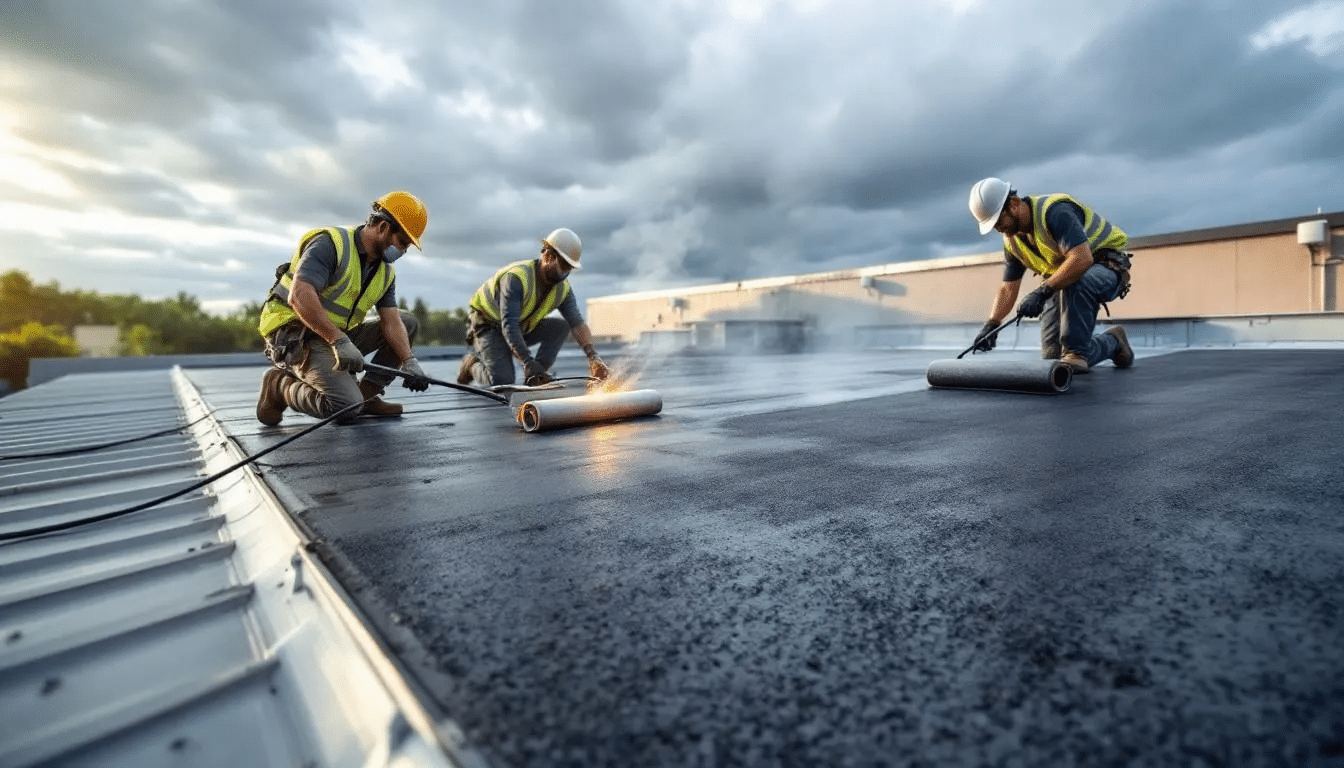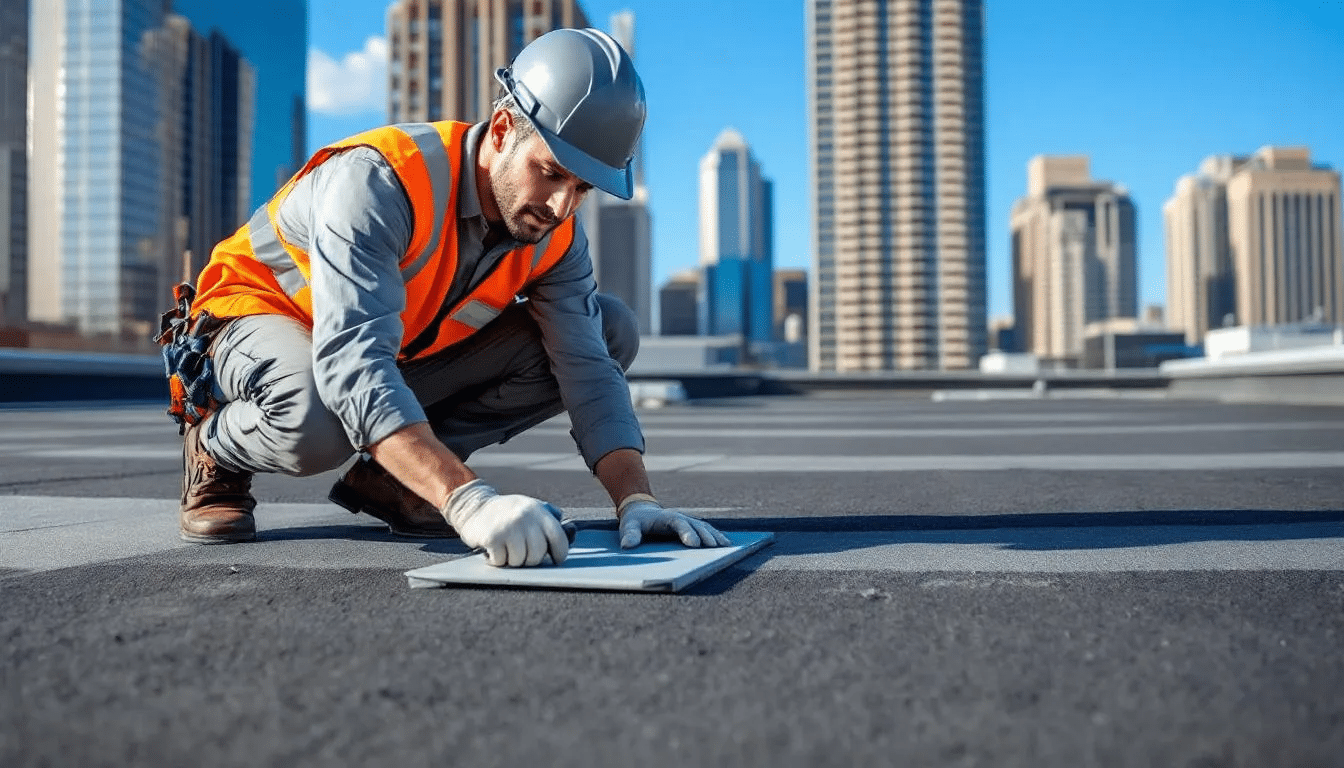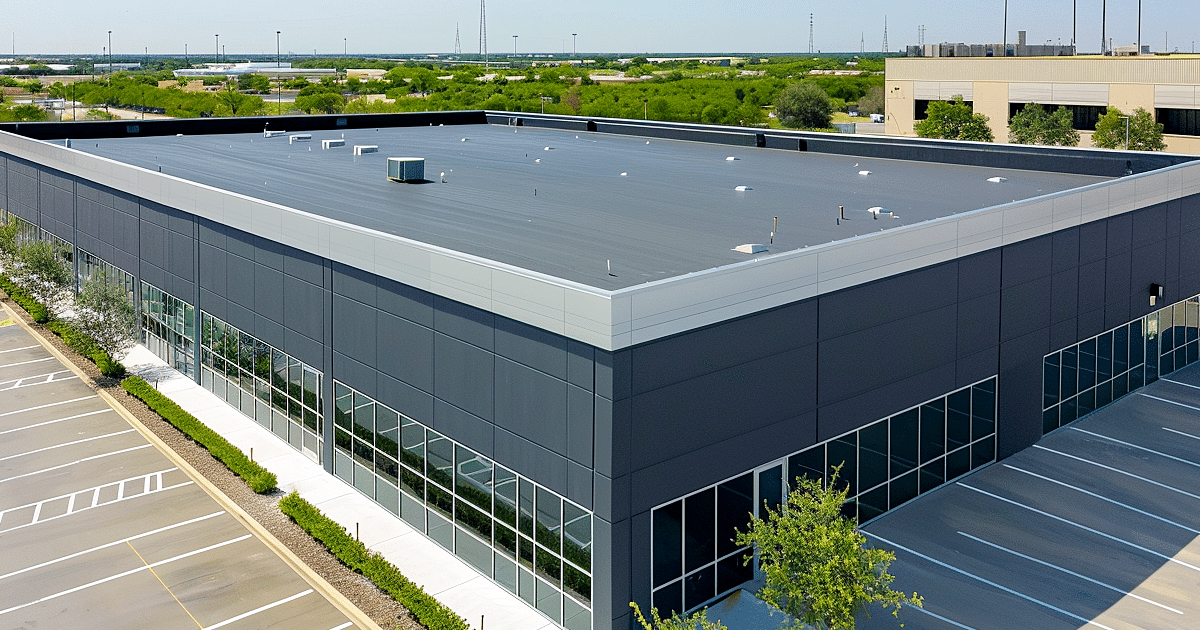Commercial property owners are always looking for roofing systems that balance strength, cost, and reliability, and that’s where the advantages of modified bitumen commercial roofing stand out. Built for flat and low-slope roofs, this material combines the time-tested durability of asphalt with modern reinforcement, giving businesses a solution that can handle heavy foot traffic, shifting Texas weather, and years of wear without constant repairs. For many building owners, it’s not just about covering a roof—it’s about investing in protection that keeps operations running smoothly while lowering long-term maintenance worries.
Key Takeaways
- Modified bitumen roofing offers exceptional durability with lifespans of 20-30 years when properly maintained
- Superior flexibility prevents cracking and accommodates building movement across temperature extremes
- Multiple installation methods (torch-applied, self-adhered, cold adhesive) provide versatility for different project needs
- Excellent waterproofing capabilities with multi-ply systems that minimize leak risks
- Cost-effective long-term investment with minimal maintenance requirements and strong ROI
Understanding Modified Bitumen Commercial Roofing
Commercial property owners seeking reliable, long-lasting roofing solutions increasingly turn to modified bitumen roofing systems for their flat and low slope roofs. Developed in the 1960s as an advancement over traditional built-up roofing systems, modified bitumen represents a sophisticated evolution in commercial roofing materials.
Modified bitumen roofing membranes consist of asphalt that has been enhanced with polymer modifiers to create a superior roofing material. The two primary types include SBS modified bitumen, which incorporates styrene butadiene styrene for rubber-like elasticity, and APP modified bitumen using atactic polypropylene for enhanced UV resistance and surface durability.
These roofing systems typically feature a multi ply system design with a base sheet and cap sheet configuration. The base sheet provides structural foundation while the cap layer offers weather protection and often includes reflective granules for energy efficiency. This multi-layer system creates redundant protection barriers that significantly outperform single-ply alternatives in many commercial applications.
Modified bitumen roofs are particularly well-suited for commercial buildings, industrial buildings, and other commercial properties with flat roofs or low sloped roofs where traditional pitched roofing materials would be impractical.
Superior Durability and Longevity
One of the most compelling advantages of modified bitumen commercial roofing lies in its exceptional service life. When installed with proper installation techniques and maintained through routine maintenance, these roofing systems consistently deliver 20-30 years of reliable performance, often exceeding the lifespan of alternative roofing options.
The inherent durability of modified bitumen stems from its composite construction. Reinforcement materials including fiberglass, polyester, or composite scrims are embedded within the modified asphalt matrix, creating a roofing membrane with superior tensile strength and puncture resistance. This robust construction makes mod bit roofs particularly valuable for commercial properties that experience regular foot traffic from maintenance personnel, HVAC technicians, or other service workers.
Modified bitumen systems demonstrate remarkable resilience against harsh weather conditions that plague many commercial roofs. The polymer-enhanced asphalt maintains its integrity through cycles of freeze-thaw, intense UV exposure, high winds, and heavy precipitation. Unlike some other roofing materials that may become brittle or degrade under constant weather exposure, modified bitumen roofing maintains its protective capabilities throughout its extended service life.
The greater thickness of modified bitumen membranes compared to single ply roofing materials provides additional protection against impact damage from hail, debris, or equipment installation. This durability translates directly into cost savings for property owners who avoid frequent repairs and premature roof replacement.
Exceptional Flexibility and Temperature Performance
Modified bitumen roofing systems excel in accommodating the thermal expansion and contraction that occurs in commercial buildings. The SBS modified formulation creates a polymerized rubber-like material that maintains flexibility across an impressive temperature range from -40°F to 180°F, far exceeding the performance range of traditional built-up roofing materials.

This exceptional flexibility prevents the cracking and splitting that commonly affects rigid roofing materials during extreme temperatures. As commercial buildings naturally expand and contract with temperature changes, the modified bitumen roof surface accommodates this movement without compromising the waterproof barrier.
The superior temperature performance proves especially valuable in regions that experience significant seasonal temperature variations. While other systems may require frequent repairs due to thermal stress, modified bitumen roofing systems maintain their integrity through countless heating and cooling cycles.
During hot weather, the membrane remains pliable and workable, allowing for easy repairs or modifications. In cold weather conditions, the material retains sufficient flexibility to prevent brittle failure, a common problem with less advanced roofing materials. This year-round flexibility contributes significantly to the long-term reliability and reduced maintenance costs that make modified bitumen an attractive investment for commercial property owners.
Outstanding Waterproofing Protection
Commercial buildings demand absolute waterproof integrity, and modified bitumen roofing systems deliver excellent waterproofing capabilities through their sophisticated multi-ply design. The typical installation creates multiple redundant barriers against water infiltration, with each layer contributing to the overall protection strategy.
The seamless application process, particularly with heat welded installation methods, creates continuous waterproof barriers without the vulnerable seams that plague mechanically fastened systems. When torch-applied or hot asphalt installation methods are used, the heat creates molecular bonds between membrane layers that form watertight seals stronger than the base materials themselves.
Modified bitumen roofs demonstrate superior resistance to ponding water, a common challenge on flat roofs where drainage may be compromised. The dense, impermeable nature of the modified asphalt prevents water penetration even when standing water remains on the roof surface for extended periods.
The multi-ply construction creates what roofing professionals call “redundant waterproofing,” where even if the cap sheet experiences minor damage, the underlying base sheet continues to provide protection. This redundancy gives building owners confidence that their commercial property remains protected from water damage that could result in costly structural repairs, mold remediation, or business interruption.
Versatile Installation Methods
Modified bitumen roofing systems offer commercial property owners and contractors exceptional installation flexibility through multiple application methods, each suited to different project requirements and site conditions. This versatility allows roofing projects to proceed efficiently regardless of weather constraints, building occupancy, or local fire safety regulations.
Torch-applied installation represents the traditional method where controlled flame heating creates strong adhesion between membrane layers and to the roof deck. This heat welded approach produces superior bond strength and immediate weatherproofing, making it ideal for projects requiring rapid completion.
Self-adhered modified bitumen systems eliminate open flame requirements, using advanced adhesive technology to create reliable bonds without torch application. These systems prove particularly valuable for occupied buildings, locations with fire restrictions, or projects where safety concerns make torch application impractical.

Cold adhesive application methods use solvent-based or water-based adhesives to bond membranes, offering installation flexibility during temperature-sensitive periods or in confined spaces where heat application might be problematic. Hot asphalt installation provides excellent adhesion for projects where traditional built-up roofing techniques are preferred.
The variety of installation options means that modified bitumen roofing can adapt to virtually any commercial roofing project timeline, budget, or site constraint. Contractors can typically install these systems faster than traditional built-up roofing, reducing labor costs and minimizing disruption to building operations.
Cost-Effectiveness and Return on Investment
When evaluating roofing options for commercial properties, modified bitumen systems consistently demonstrate strong cost effectiveness through a combination of reasonable initial costs and exceptional long-term value. Initial installation costs typically range from $4-9 per square foot, positioning modified bitumen competitively against other commercial roofing systems while offering superior performance characteristics.
The true economic advantage emerges through the system’s extended service life and minimal maintenance requirements. Over a 20-30 year lifespan, the annual cost of modified bitumen roofing often proves significantly lower than alternatives requiring more frequent replacement or extensive maintenance.
Property owners benefit from the ease of repair that characterizes modified bitumen systems. Minor damage can often be addressed through heat welding techniques or patch applications without requiring extensive roof replacement. This repairability extends the roof system’s useful life and prevents small issues from escalating into major expenses.
The overlay capabilities of modified bitumen provide additional cost savings when roof restoration becomes necessary. Rather than expensive tear-off procedures, many modified bitumen installations can be overlaid or restored, reducing disposal costs and installation time while extending roof life.
For commercial properties operating on tight maintenance budgets, the predictable performance and low maintenance requirements of modified bitumen roofing create valuable budget stability. Property owners can plan maintenance schedules around routine inspections rather than emergency repairs, improving operational efficiency and reducing unexpected expenses.
Energy Efficiency Benefits
Modern modified bitumen roofing systems contribute significantly to building energy efficiency through advanced surface technologies and reflective capabilities. Many modified bitumen roofing membranes feature reflective granules or specialized cap sheets designed to reduce heat absorption and lower cooling costs.
Cool roof options within the modified bitumen category can achieve high solar reflectance values, reflecting solar radiation away from the building rather than absorbing it into the roof structure. This heat reduction translates directly into reduced cooling loads and lower energy costs, particularly valuable for commercial buildings in hot climates.
Studies indicate that properly designed reflective modified bitumen systems can reduce cooling costs by 10-20% compared to traditional dark-colored roofing materials. These energy savings compound over the roof’s service life, contributing to the overall return on investment.
Many modified bitumen products qualify for ENERGY STAR certification, making them eligible for utility rebates, tax incentives, or green building certifications like LEED. These financial incentives can offset initial installation costs while supporting corporate sustainability goals.
The thermal performance of modified bitumen roofing also contributes to more stable indoor temperatures and reduced strain on HVAC equipment. This improved thermal stability can extend HVAC system life and reduce maintenance requirements for mechanical systems.
Low Maintenance Requirements
One of the most attractive advantages of modified bitumen commercial roofing lies in its minimal maintenance requirements compared to other roofing systems. The robust construction and proven durability of mod bit roofs translate into straightforward maintenance protocols that commercial property owners can easily implement.
Semiannual inspections represent the primary maintenance requirement for modified bitumen roofing systems. These routine inspections allow property owners to identify potential issues before they become serious problems, maintaining the building’s protection while avoiding emergency repairs.

The inspection process for modified bitumen roofs focuses on checking seams, flashings, drains, and areas around roof penetrations – common vulnerability points for all roofing systems. Early warning signs of potential issues are typically easy to identify, allowing for prompt attention before problems escalate.
When maintenance is required, modified bitumen systems offer exceptional ease of repair. Small punctures, seam separations, or localized damage can often be addressed through heat welding techniques or patch applications using compatible materials. These repairs integrate seamlessly with the existing roof system, restoring full waterproof integrity without compromising long-term performance.
The resistance to foot traffic damage means that routine maintenance activities, HVAC servicing, or equipment installation causes less wear on modified bitumen roofs compared to more delicate roofing materials. This durability reduces maintenance frequency and allows normal building operations to proceed without constant concern about roof damage.
Fire and Wind Resistance
Modified bitumen roofing systems provide excellent fire resistance characteristics that meet or exceed commercial building code requirements. The asphalt-based composition of these roofing materials creates natural fire resistance, with many systems achieving Class A fire ratings when installed over appropriate roof deck assemblies.
The multi-ply construction and substantial mass of modified bitumen systems contribute to superior wind uplift resistance compared to lighter single-ply alternatives. The strong adhesion achieved through proper installation creates a roof system that remains intact even under severe wind conditions.
Wind uplift testing demonstrates that properly installed modified bitumen roofing can withstand harsh weather conditions including high winds, wind-driven debris, and severe storms. This performance reliability provides commercial property owners with confidence in their roof system’s ability to protect their investment during extreme weather events.
The fire resistance of modified bitumen roofing often translates into favorable insurance premiums for commercial properties. Insurance providers recognize the reduced risk profile associated with these proven roofing systems, particularly when compared to roofing materials with poor fire performance histories.
Commercial buildings in hurricane-prone regions benefit from the proven record of accomplishment of modified bitumen systems in withstanding severe weather. The combination of strong adhesion, flexible accommodation of building movement, and resistance to impact damage makes these systems particularly well-suited for challenging coastal environments.
Adaptability to Complex Roof Designs
Commercial buildings often feature complex roof configurations with multiple levels, equipment installations, and architectural details that challenge conventional roofing systems. Modified bitumen roofing excels in these applications through its exceptional conformability and installation versatility.
The workable nature of modified bitumen membranes allows them to conform to irregular roof shapes, navigate around HVAC equipment, and accommodate complex architectural features that would be problematic for rigid roofing materials. This adaptability reduces installation complexity and ensures complete waterproof coverage regardless of roof geometry.
Expansion joints, structural details, and roof penetrations present ongoing challenges for commercial roofing systems. Modified bitumen’s flexibility and heat-weldable characteristics allow for reliable sealing around these critical areas, preventing the leak development that commonly occurs at interface points.
The compatibility of modified bitumen with various roof deck types – including concrete, steel, wood, and composite materials – makes it suitable for both new roofing system installations and re-roofing projects. This versatility simplifies material selection and ensures optimal performance regardless of the underlying structure.
For commercial properties requiring roof restoration rather than complete replacement, modified bitumen systems can often be installed over existing roofing materials, provided the roof deck remains structurally sound. This overlay capability reduces project costs and minimizes disruption to building operations.
The ability to accommodate green roofing systems, solar installations, and other sustainable building technologies makes modified bitumen an excellent choice for forward-thinking commercial properties. The strong, stable platform provided by these roofing systems supports additional building systems while maintaining waterproof integrity.
FAQ
How does modified bitumen compare to TPO roofing systems and EPDM for commercial applications?
Modified bitumen offers superior puncture resistance and foot traffic durability compared to TPO roofing systems and EPDM. While single-ply systems like TPO may be faster to install on large, unobstructed roofs, modified bitumen provides better long-term performance in high-traffic areas and complex roof configurations. The multi-ply design creates redundant protection that single-ply systems cannot match, though initial costs may be slightly higher.
What warranty options are available for modified bitumen commercial roofing systems?
Most manufacturers offer 15-20 year material warranties for modified bitumen products, with some premium systems qualifying for 25-30 year coverage. Warranty terms typically require proper installation by certified contractors and adherence to specified maintenance protocols. Many manufacturers also offer system warranties that cover both materials and installation when installed by approved contractors, providing comprehensive protection for commercial property owners.
Can modified bitumen be installed over existing roofing materials?
Yes, modified bitumen systems can often be installed over existing roofing materials, provided the roof deck is structurally sound and the existing surface is properly prepared. This overlay capability makes modified bitumen an excellent choice for roof restoration projects, eliminating costly tear-off procedures and disposal fees. However, a professional evaluation is essential to ensure the existing roof can support the additional weight and that proper adhesion can be achieved.
What safety considerations are important during modified bitumen installation?
Torch-applied installation requires strict fire safety protocols, including fire watches, proper ventilation, and coordination with building occupants. Self-adhered systems eliminate open flame requirements, making them safer for occupied buildings or fire-sensitive locations. All installation methods require proper fall protection, adequate ventilation for fumes, and trained personnel familiar with the specific installation techniques. Safety planning should always involve coordination with local fire departments and building management.
How do weather conditions affect modified bitumen installation schedules?
Modified bitumen installation can proceed in most weather conditions, though extreme temperatures may affect installation methods. Cold weather may require special low-temperature adhesives or extended heating times for torch applications. Hot weather conditions are generally favorable for installation but may require adjusted work schedules to avoid excessive heat exposure for workers. Rain or high humidity can delay installation, as moisture must be eliminated before membrane application to ensure proper adhesion.
Contents
- Understanding Modified Bitumen Commercial Roofing
- Superior Durability and Longevity
- Exceptional Flexibility and Temperature Performance
- Outstanding Waterproofing Protection
- Versatile Installation Methods
- Cost-Effectiveness and Return on Investment
- Energy Efficiency Benefits
- Low Maintenance Requirements
- Fire and Wind Resistance
- Adaptability to Complex Roof Designs
- FAQ



